PRINCETON, NJ -- Gallup's Job Creation Index improved to its best level of 2010 last week, providing at least a few Americans with some much-needed Valentine's Day cheer. Gallup's Economic Confidence Index was unchanged, and self-reported consumer spending declined from the prior week and from a year ago.
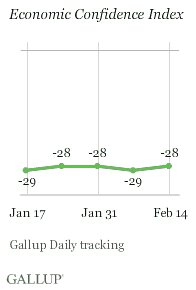

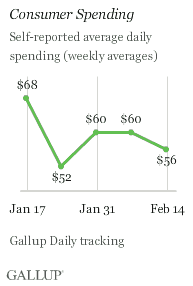
What Happened (Week Ending Feb. 14)
-
Job Creation improved to its best level of 2010, reaching +3 -- up from 0 last week and -2 a month ago. Job market conditions improved, in terms of both hiring, with 26% of employees reporting that their companies are hiring -- up from 24% the prior week -- and layoffs, with 23% saying their employers were letting people go, vs. 24% the previous week. While one week may not mark a new trend, last week was the best week for job market conditions so far in 2010.
-
Consumer Spending during Valentine's Day week did not provide much to celebrate. Last week, self-reported daily spending in stores, restaurants, gas stations, and online averaged $56 per day -- down from $60 the prior week, and down 18% from the same week a year ago ($68). Although last week's massive snowstorms could have affected spending, consumer spending continues to disappoint: the January 2010 daily average of $62 trailed last year's $64; similarly, spending during the first two weeks of February ($60 and $56, respectively) trail the February 2009 average ($64).
-
Economic Confidence was unchanged, as Gallup's Economic Confidence Index stood at -28 -- essentially the same level seen in the previous four weeks. Forty-six percent of Americans rated the economy "poor" and 11% rated it "excellent" or "good." Thirty-seven percent said the economy is "getting better" while 57% said it is "getting worse." Consumers' optimism seems to have been largely unaffected by either the slight improvement in job creation or the decline in consumer spending.
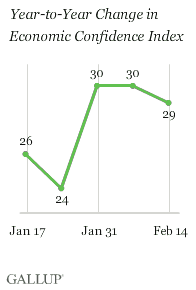
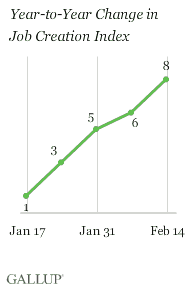
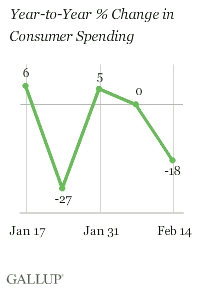
What to Watch For
Gallup's monitoring of consumers' self-reported spending continues to reflect last year's "new normal." Consumers spent a lot less in January than they did in December (down 14%). Spending was also slightly less over the first six weeks of 2010 than it was during the comparable weeks of early 2009. This seems to have considerable face-validity given the current jobs situation as well as the lack of improvement in economic confidence. But it contrasts with recent government reports showing a slight increase in retail sales from December to January and an even larger year-over-year increase -- with some of this difference likely being because Gallup does not apply seasonal adjustments.
Employee reports that job market conditions remain dismal also reflect the "new normal." The layoff rate is down from this time in 2009 -- reflecting the fact that many companies have already adjusted to the new normal in spending. As is well known, the real job problem right now is that companies are not currently hiring at any faster rate than they did during the depths of the recession a year ago. While the government's economic data show the economy recovering from nearly two years of recession, there appear as yet few signs of improvement in the job market, particularly as Americans point to unemployment as the nation's most important problem.
In this regard, last week's hiring numbers are encouraging. If spending by consumers and business increases and this improvement turns out to be more than the one- or two-week blips that have happened several times over the past couple of years, there would be reason for renewed optimism. Increased hiring would not only improve the lives of currently unemployed Americans but would mean more spending -- in turn, creating a positive growth cycle as opposed to the downward recessionary spiral of early 2009.
On the other hand -- and potential signs of modest job growth aside -- the seeming failure of Congress to produce significant bipartisan jobs legislation is somewhat discouraging, as is the renewed focus on healthcare reform. If there is ever a time when the politicians in the nation's capital should come together to focus their energy on creating jobs, it would seem to be now -- during an election year -- when their own jobs are at stake.
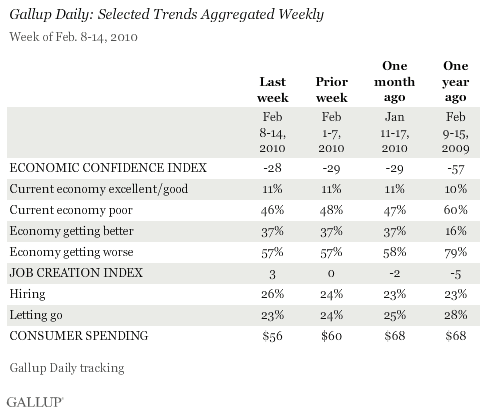
Review and export the complete daily trends on these measures: Economic Indexes; Consumer Spending; Economic Outlook; Economic Conditions; Job Market
Learn more about Gallup's economic measures.
On Feb. 23, 2010, at its world headquarters in Washington, D.C., Gallup for the first time will release the findings from its daily U.S. employment tracking, including insights into the U.S. workforce's state of mind. Learn more ...Survey Methods
For Gallup Daily tracking, Gallup interviews approximately 1,000 national adults, aged 18 and older, each day. The Gallup consumer perceptions of the economy and consumer spending results are based on random half-samples of approximately 500 national adults, aged 18 and older, each day. The Gallup job creation and job loss results are based on a random half sample of approximately 500 current full- and part-time employees each day. Results from the week of Feb. 8-14, 2010, are based on telephone interviews with 3,407 adults for the consumer perceptions and spending questions. For these results, one can say with 95% confidence that the maximum margin of sampling error is ±3 percentage points. Results for the job creation and job loss questions are based on interviews with 3,957 employees, with a maximum margin of error of ±3 percentage points.
Interviews are conducted with respondents on land-line telephones and cellular phones.
In addition to sampling error, question wording and practical difficulties in conducting surveys can introduce error or bias into the findings of public opinion polls.
